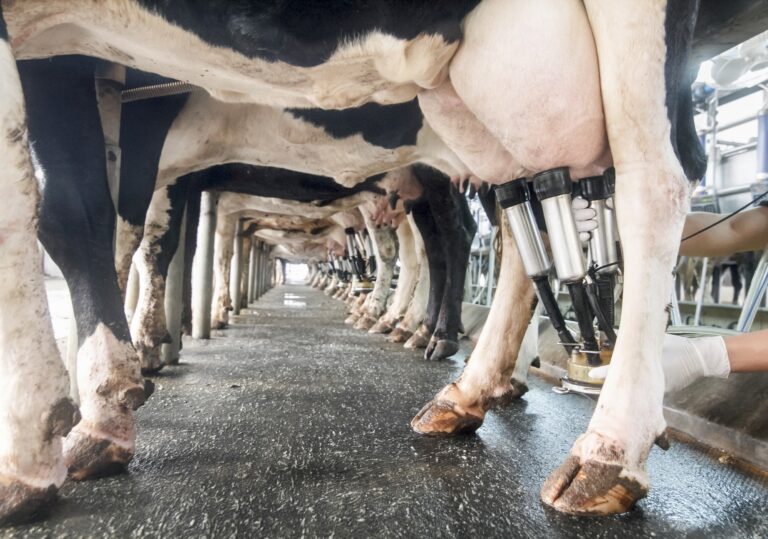A recent study published in the journal NatureA group of researchers characterized the pathogenicity and transmissibility in mammals of cow’s milk-borne highly pathogenic avian influenza (HPAI H5N1) virus, a severe and highly contagious avian influenza that infects humans and mammals.
Study: Pathogenicity and transmissibility of bovine H5N1 influenza virus. Image credit: Toa55 / Shutterstock
background
After dairy cows in Texas developed unexplained symptoms and lost milk production, highly pathogenic avian influenza H5N1 was detected in milk and nasal wash samples on March 25, 2024. By May 30, 2024, the United States Department of Agriculture (USDA) had confirmed 69 infected herds in nine states, with spread linked to cow movement and possible transmission through contaminated milking equipment. This outbreak, along with cases in farm workers and cats, highlights the public health risk. The bovine H5N1 virus is closely related to North American wild bird lineages. Further research is needed to understand its replication, pathogenicity, and transmission to mammals.
About the Research
In this study, animals were acclimated to the facility before the start of the experiments, housed under a 12-h light/dark cycle, and provided with food, water, and enrichment. Humane endpoint criteria included ≥35% weight loss or upright immobility. In the United States, HPAI viruses are classified as “select pathogens” by federal regulations, which require immediate reporting to the Federal Select Pathogens Program. All experiments were performed in a biosafety level 3 (BSL-3) laboratory at the University of Wisconsin-Madison Influenza Institute, which is approved for the study of these viruses. This study was funded by the National Institute of Allergy and Infectious Diseases (NIAID) Center of Excellence for Influenza Research and Response (CEIRR). All animal experiments and procedures were approved by the Institutional Care and Use Committee of the University of Wisconsin-Madison College of Veterinary Medicine.
Madin-Darby canine kidney (MDCK) cells were used for virus isolation and amplification, and no mutations occurred during passaging in these cells. The isolated virus, A/dairy cattle/New Mexico/A240920343-93/2024 (H5N1), was fully sequenced and found to be part of the same lineage as other published bovine H5N1 virus sequences. This virus and a control virus were used for all studies. Mice and ferrets were used to test replication, virulence, and respiratory droplet transmission. Lactating mice were also used to study vertical transmission. Tissue samples were collected for virus titration and plaque assays, and receptor specificity was compared between different virus strains. The study was reviewed and approved by the relevant institutional committees, and the NIAID grant for the study was determined not to meet the criteria for Dual Use Research of Concern (DURC).
research result
To assess the public health risk of milk containing the H5N1 virus, researchers demonstrated that oral ingestion of milk from cows infected with HPAI H5N1 resulted in rapid disease symptoms and virus spread in Bagg Albino Laboratory-Bred Mouse/C strain J (BALB/cJ) mice. When the experiment was repeated with smaller volumes of milk, significant weight loss and increased virus titers in the lungs, nasal turbinates, and brain were observed in mice inoculated with 25 μl or 10 μl of infected milk. In contrast, mice inoculated with 25 μl of milk from healthy cows showed no symptoms. Mice inoculated with smaller volumes (5 μl and 1 μl) showed fewer overt signs of disease and sporadic virus replication. Surviving mice did not seroconvert.
To assess pathogenicity after respiratory exposure, female BALB/cJ mice were inoculated with serial dilutions of Cow-H5N1 and body weight and survival were monitored. The mouse lethal dose (MLD50) was 31.6 PFU, which was similar to that of the Spanish HPAI H5N1 mink virus lineage 2.3.4.4b but higher than that of the avian H5N1 virus A/Vietnam/1203/2004 (VN1203)-H5N1. Tissue tropism studies revealed systemic infection with Cow-H5N1 and VN1203-H5N1, with high virus titers in respiratory and non-respiratory tracts, including mammary gland, nipple, and muscle tissues. Isumi-H1N1 virus was detected only in respiratory tissues. Infected ferrets showed a similar virus replication pattern with high titers in respiratory and nonrespiratory organs, but no virus was detected in blood or muscle tissue.
We next tested whether lactating mice could transmit Cow-H5N1 vertically to their pups or to contact adult mice. Lactating female mice were inoculated and either reunited with their pups or with non-lactating adult mice. Virus replication was observed in lactating female mice, and some of their pups became infected, but virus was not detected in contact adult mice. Virus was detected in the mammary glands and milk of some lactating female mice, suggesting vertical transmission via milk.
Finally, respiratory droplet infection experiments in ferrets showed that Isumi-H1N1 was efficiently infectious, whereas Cow-H5N1 was not; however, one of the infected ferrets had a low positive hemagglutination inhibition (HI) titer, indicating a possible inefficient infection. Receptor binding specificity studies revealed that, unlike the avian VN1203-H5N1 virus, Cow-H5N1 binds to both α2,3- and α2,6-linked sialic acids, suggesting that Cow-H5N1 may bind to cells of the upper respiratory tract in humans.
Conclusion
In summary, HPAI H5N1 influenza viruses are not typically transmitted efficiently between mammals, and influenza A viruses are rarely detected in cattle. However, the current HPAI H5N1 outbreak in dairy cattle and its spillover to other mammals poses a significant risk to public health and the dairy industry. Despite more than 850 human infections, sustained mammal-to-mammal transmission has not been reported, although recent outbreaks in mink and marine mammals suggest that it may be possible. In this study, bovine HPAI H5N1 virus demonstrated limited respiratory droplet transmission in ferrets, supporting findings of potential mammal-to-mammal transmission. The virus also exhibits human/avian-type dual receptor binding specificity, highlighting the pandemic potential of these viruses.


